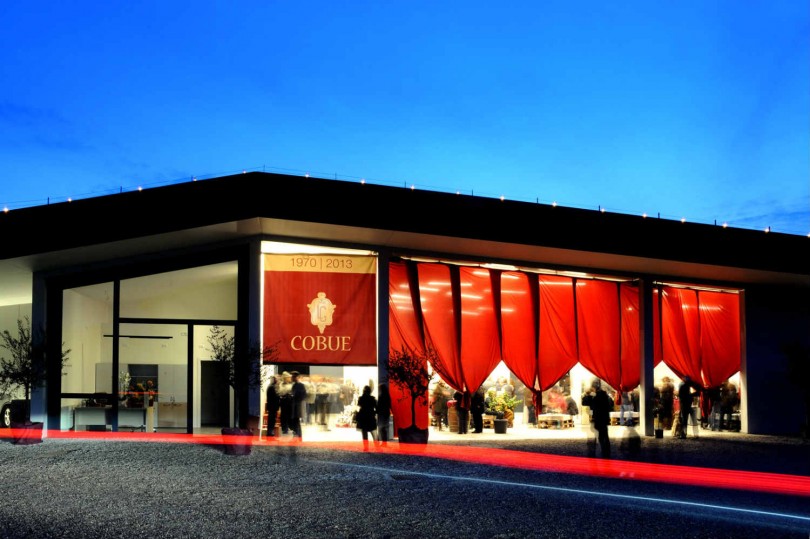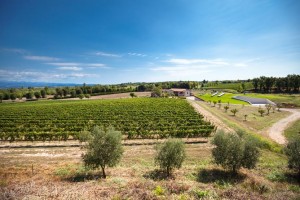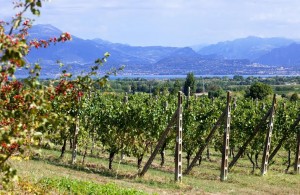“Please, don’t think we only produce Lugana, even if we are in the heart of the land where this wine is commonly produced”. This could be the slogan that sums up the philosophy of Gilberto Castoldi, who runs the Cobue winery with hus sister Simona, his father Aurelio and mother Laura Gettuli. We are in Pozzolengo, in the heart of the “Lugana Valley” that is now exporting all around the world in the wake of a phenomenon that seems really unstoppable, but this family seems determined to go against the current, dedicating to the famous white Lake Garda wine only 50% of a production of 100 thousand bottles. And the rest? Well, for example Cobue still believes a lot in San Martino della Battaglia, another Doc white wine of the same area which over the years has been supplanted by the fortunes of the much more famous cousin. Luckily, a handful of producers continue to keep it alive by cultivating the difficult but ultimately very rewarding Tuchi grapes (as the Tocai have been renamed on the Garda area after the use of the original name of the grape has been reserved by the European Commission to Hungary alone).
In a range of nine labels you will find just one Lugana, called Monte Lupo: and then there is Garda Classico Doc Red (Il Poggio) awarded with the “Daily Wine” prize in the 2016 Slowine Guide by Slow Food, there is a Marzemino, and two ambitious sparkling wines, strictly blanc de blanc, and so Chardonnay 100%, one brut and one pas dose, who are sold only after aging for 36 months on the lees. The white and red Getulio (two IGT Benaco Bresciano) are considered a bit the crown jewels, taking their name from Laura Gettuli, originally from Valeggio and real owner of the company inherited from his father’s family.
“My granddad had made his fortune in Milan in other working areas and wanted to return home to create his own farm – tells Gilberto -. In 1970 he bought this estate where they already naturally produced wine, but also milk, pigs, corn … It was him who woke the passion for the countryside in me: when I was a child he brought me in the vineyards and to the cattle market, introducing me to a world that I always found deeply fascinating. I also tried to do some other jobs, but then I came back here to take care full time of the family company: I can say that 2005 was the year when I began working on the first vintage of the new course. ”
Cobue is therefore a still young brand, although one certainly determined: the hectares of vineyards are 15 on a total of 25 in the estate ( “And we will plant no more” says Castoldi), the new winery was built in 2013 completely underground, and the goal is to reach a production of 150,000 bottles once the entire vineyard will be producing fully after the last portions of vineyard have been planted.
Soon, Cobue will invest in trasnforming part of the farm in a cutting-edge “agriturismo” with swimming pool, a passive house climate-zero energy with a total of 6 or 7 apartments, tasting room for events, and who knows, soon also a place to eat. This will complete the profile of a reality that Gilberto calls “territorial entity.”
“We are not mono-Lugana for a precise choice – he explains-. We want to make Cobue wine, we want people to ask for Cobue quality, not to buy simply because Lugana is going strong.”
And the company is in contrast with the rest of the territory also with regard to the selling of the products.
“Our market is 90% in Italy and for the remaining 10% in Germany. We dont’ want to export at any cost even if we recently began to work in Estonia and the USA. But above all we are proud to be grounded in our land, with the province of Brescia representing 50% of our sales, and to be present in the wine lists of all the Michelin Star on the Brescia coast of Lake Garda, as well as in that of the two Michelin star Miramonti L’Altro in Concesio, always near Brescia”.
The bottle.
The San Martino della Battaglia Doc Monte Olivi is perhaps the wine of which Gilberto and his family hold most dear. “10% of our production is represented by Tuchi, as Tocai was called in locale dialect: and between last year and this year we have planted nearly a hectare – explains the owner not without pride -. We are also grafting our clones on the old vines planted by my grandfather in the 70s.”
Believe me, this in an admirable effort to help save a wine almost endangered, which also in the passionate, delicate declination by Cobue confirms a rebirth which must be followed very carefully: even if only to treat yourself every now and then with an alternative of great charm and personality to the overwhelming power of Lugana. And look out for the “vendemmia tardiva” which Cobue also produces with Tuchi: it is called Passum, it’s a little production of about 2000 bottles made exclusively with grapes let to overipe exclusively on the plant, conceived by Gilberto to be matched with cheeses and with his love for “Eiswein” in mind.




Leave a Comment